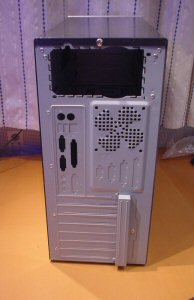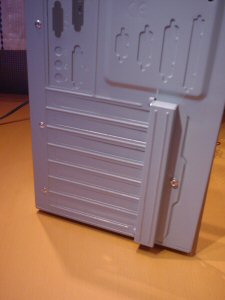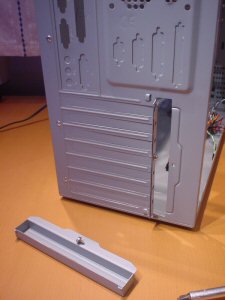External Appearance 3
Below the space for the PSU to sit is the I/O plate that is stamped out 0.8mm zinc coated steel. This can be removed by simply twisting the I/O plate till the fixing breaks loose. Motherboards with strange port layouts are often supplied with a suitable I/O plate. Once the standard I/O plate has been removed, the new I/O plate can be simply pushed into place. To the right of the I/O plate are additional spaces for ports. These spaces for ports are often useful if you have devices such as an LCD mounted in the drive bays of the case. Small LCD’s are often powered via a USB/Serial cable and require a cable be run to the external ports. If you are handy with wiring you can install a connection into these blank ports and create a loop cable to go between the connector on your I/O plate to a connector installed in the blank ports. Above these additional ports is space for an 80mm case fan. (Fan not included). The holes for the opening are shaped like fan blades. This is a clear indication to novice computer users to what this area is for. Although it is quite a nice design I feel it restricts airflow quite a lot. This could easily be solved using a Dremel or drill attached with a hole saw cutter.
The PCI slots are covered by something I haven’t seen before on a case. At first I was a little confused at how it was supposed to work. Since I was baffled over this I expected to see some sort of instructions within the user manual but this wasn’t to be. It appears to be a type of security system to protect your PCI cards. Basically you install all your cards into your computer system and then screw them in with the bracket in place. This means that if you wish to remove a card from your system you need to remove all the screws that are holding the other cards in place, remove the card and then screw all the screws back in place. Yes this maybe a good security feature but it seems to be a lot of hassle. Also the bracket that is screwed across the cards doesn’t seem to cover the AGP card. I’d like to say that if a thief at a LAN party was to steal a card from your PC, I’d expect they would take your AGP card as this is often the most expensive card in your system. To add further security and tidy up the appearance of the rear of the case a cover is then installed over the bracket to hide all the unsightly screws.


An area that I and many other reviewers often tend to forget about when reviewing computer cases is the feet. Unfortunately the Centurion case doesn’t wear Nike trainers… they are more like Hi-Tec. They are the boring old plastic feet that are often found on that old 486 case that you binned 5 years ago. It’s quite ironic that Lian Li still use this style of feet on their computer cases too. Whereas most Cooler Masters have a touch of class with a gold and rubber band design, similar to what is found on high quality stereos.










